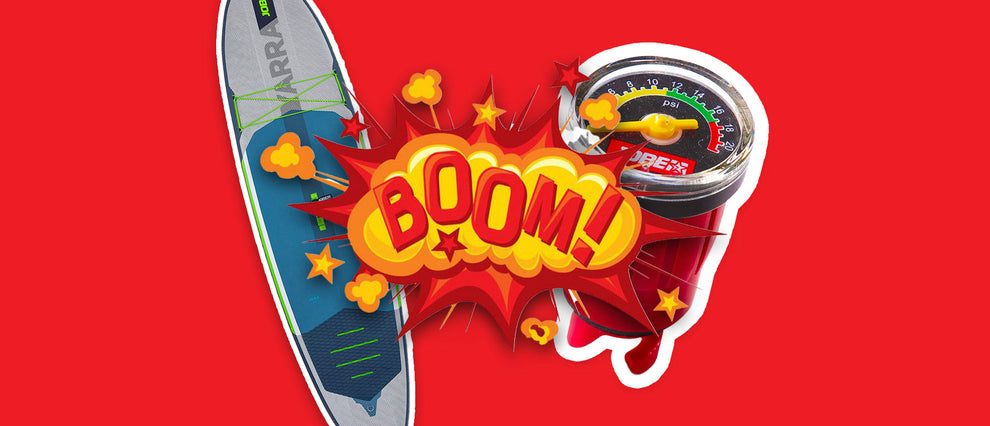Ever wondered if your board's pressure matches the weather's mood? Unravel the perfect balance by reading this blog post!
Paddleboarding has gained immense popularity over the years, attracting adventure enthusiasts, fitness enthusiasts, and nature lovers alike. Whether you're exploring lakes, tackling white-water rapids, or riding ocean waves, a paddleboard serves as your trusty companion on the water. While the allure of paddleboarding lies in its simplicity, it is crucial to understand the importance of maintaining proper air pressure and monitoring heat to ensure the longevity and safety of your paddleboard. In this blog post, we will dive into why these factors are vital for paddleboard maintenance.
Stability and Performance:
One of the primary reasons to maintain proper air pressure in your paddleboard is to ensure stability and optimal performance on the water. When inflated to the manufacturer's recommended pressure, the paddleboard achieves its intended shape, providing the necessary buoyancy and rigidity. Proper inflation ensures that the paddleboard remains stable, allowing you to maintain balance while paddling and maneuvering through varying water conditions.
On the other hand, underinflated paddleboards can feel sluggish and unstable. The lack of rigidity leads to a decrease in responsiveness and maneuverability, affecting your overall experience on the water. Moreover, an underinflated board is more prone to submerging or dipping into the water, leading to reduced speed and increased drag. By regularly monitoring and maintaining air pressure, you can optimise your paddleboarding experience and enjoy improved stability and performance.
Structural Integrity:
The structural integrity of a paddleboard relies heavily on maintaining the correct air pressure. When exposed to excessive heat or direct sunlight, the air inside the board expands, increasing the internal pressure. If the pressure surpasses the recommended limit, it can result in structural damage, weakening the board's construction over time. This can lead to irreparable cracks, delamination, or even complete failure of the board.
To prevent such issues, it is crucial to be mindful of the environmental conditions in which you store and transport your paddleboard. Avoid leaving it exposed to direct sunlight for extended periods, especially during hot summer days. When not in use, store your board in a shaded, well-ventilated area, away from extreme temperatures. Regularly inspect the board for any signs of damage, paying close attention to seams, valves, and the general overall condition.
Safety Considerations:
Maintaining proper air pressure and monitoring heat is not only essential for the longevity of your paddleboard but also for your safety on the water. An underinflated board can compromise your stability, making it more challenging to control the paddleboard. This can lead to unexpected falls and accidents, particularly in rough or choppy waters.
Maintaining proper air pressure and monitoring heat are fundamental aspects of paddleboard maintenance. By keeping your paddleboard adequately inflated to the recommended pressure, you enhance stability, performance, and overall durability. Additionally, monitoring heat and preventing excessive expansion of air pressure safeguards the structural integrity of your paddleboard. By practicing these essential maintenance routines, you can ensure a safer, more enjoyable, and prolonged paddleboarding trips. Remember, a well-cared-for paddleboard will be your trusted companion for countless adventures on the water.
Jobe inflatable paddle boards boast unparalleled stiffness and airtight qualities, setting them apart as the best in the market. These boards can be inflated up to an impressive 20 PSI, providing maximum performance compared to other boards limited to 15 PSI.
As specialists, we recommend inflating your paddleboard to around 18 PSI, allowing some room for the air to expand and ensuring the overall integrity of the board. It's essential to strike a balance between pressure and board performance.
Keep in mind that inflating the board to such high pressure manually will work your triceps, so be prepared for a bit of a workout.
If you're willing to compromise a bit on maximum performance, you can still enjoy your board by inflating it to somewhere between 16-18 PSI, adjusting based on your weight. However, be aware that paddling won't be as smooth, and the board may bend under your weight, leading to wet feet if delated too low.
The higher the PSI level, the smoother the paddling experience because the board won't bend. This is why we always recommend inflating up to 20 PSI for optimal performance. Nevertheless, it's ultimately a trade-off between board performance and the time and energy spent on inflating. Through trial and error, you'll discover your preferred PSI level that strikes the right balance for you.
Hope this helps and thank you for taking the time reading our blog.
Give us a call on 01454 261058 if you have any questions





Join the discussion 0 Comments